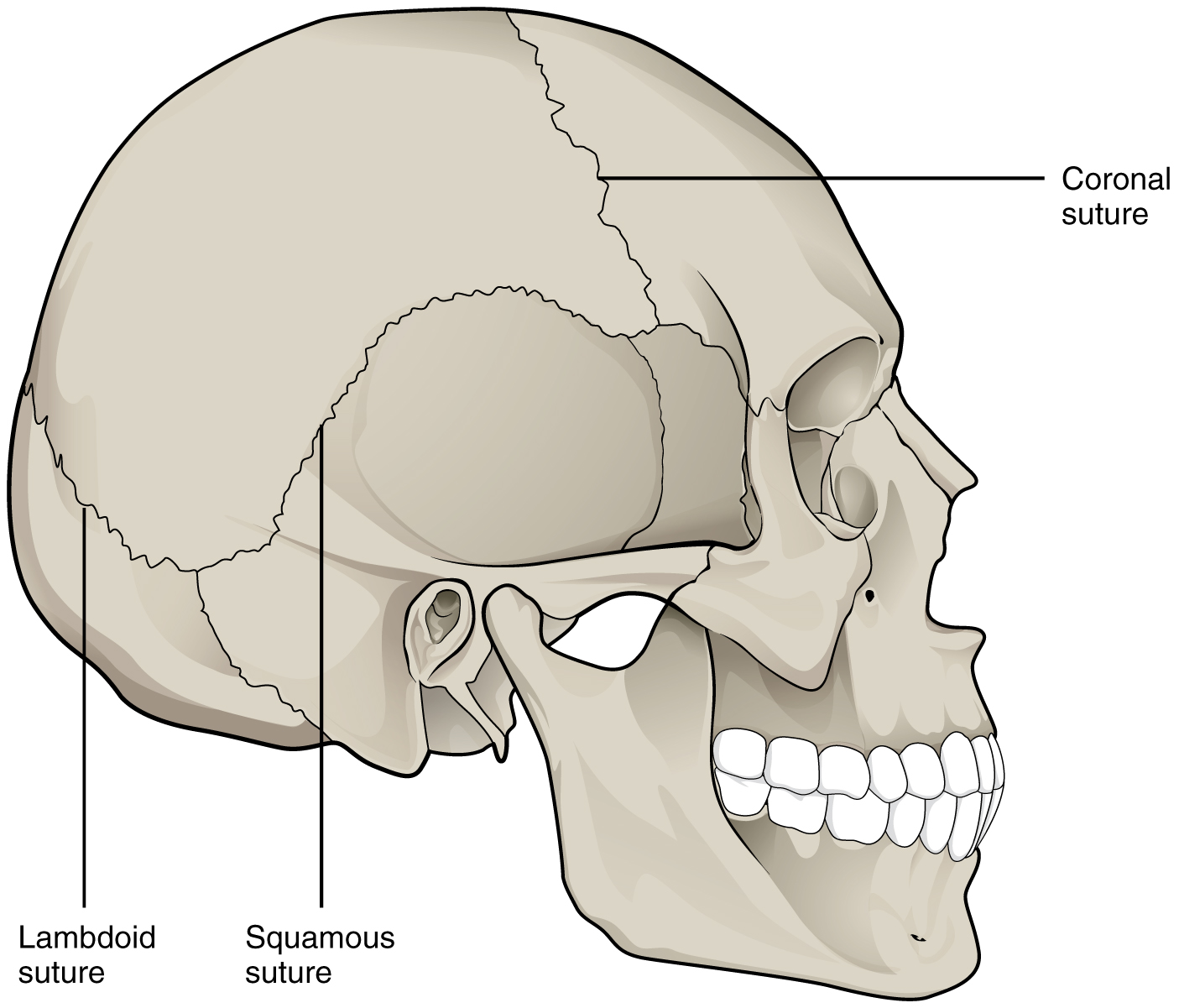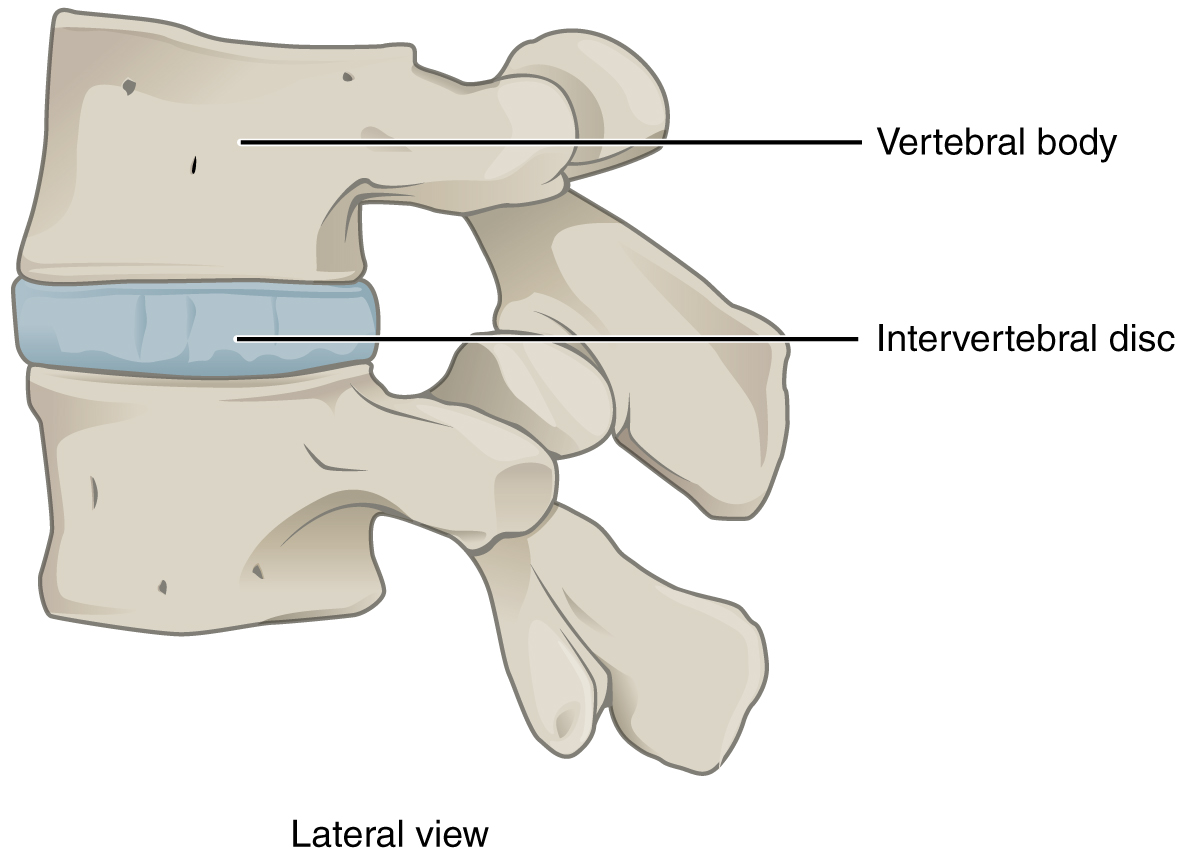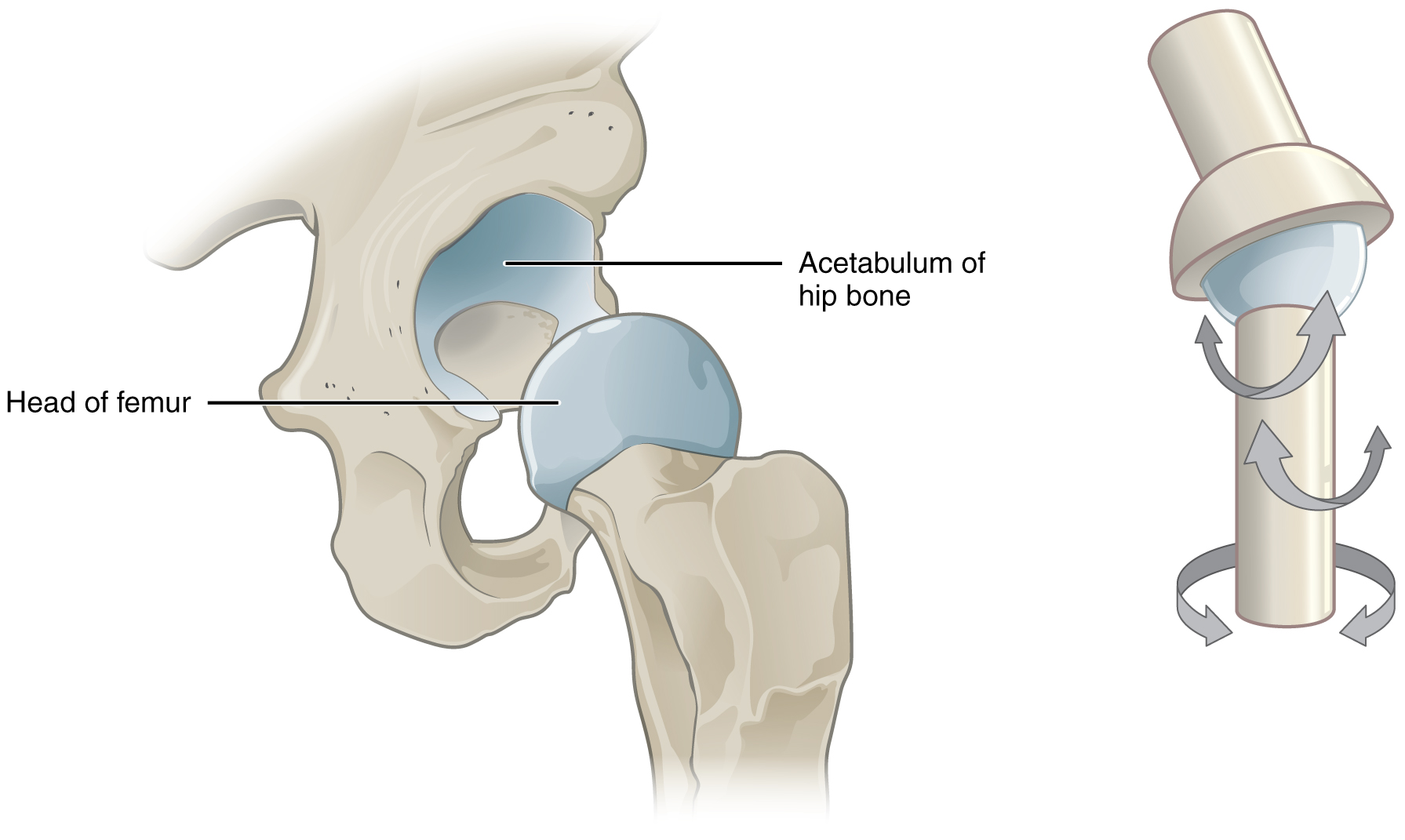9.1 Classification of Joints
Learning Objectives
By the end of this section, you will be able to:
- Distinguish between the functional and structural classifications for joints
- Describe the three functional types of joints and give an example of each
- Describe the three structural types of joints and give an example of each
- Describe the planes of movement possible in diarthrodial joints
A joint, also called an articulation, is any place where adjacent bones or bone and cartilage come together (articulate with each other) to form a connection. Joints are classified both structurally and functionally. Structural classifications of joints take into account whether the adjacent bones are strongly anchored to each other by fibrous connective tissue or cartilage, or whether the adjacent bones articulate with each other within a fluid-filled space called a joint cavity. Functional classifications describe the degree of movement available between the bones, ranging from immobile, to slightly mobile, to freely moveable joints. The amount of movement available at a particular joint of the body is related to the functional requirements for that joint. Thus immobile or slightly moveable joints serve to protect internal organs, give stability to the body, and allow for limited body movement. In contrast, freely moveable joints allow for much more extensive movements of the body and limbs.
Structural Classification of Joints
The structural classification of joints is based on whether the articulating surfaces of the adjacent bones are directly connected by fibrous connective tissue or cartilage, or whether the articulating surfaces contact each other within a fluid-filled joint cavity. These differences serve to divide the joints of the body into three structural classifications. A fibrous joint is where the adjacent bones are united by fibrous connective tissue. At a cartilaginous joint, the bones are joined by hyaline cartilage or fibrocartilage. At a synovial joint, the articulating surfaces of the bones are not directly connected, but instead come into contact with each other within a joint cavity that is filled with a lubricating fluid. Synovial joints allow for free movement between the bones and are the most common joints of the body.
Functional Classification of Joints
The functional classification of joints is determined by the amount of mobility found between the adjacent bones. Joints are thus functionally classified as a synarthrosis or immobile joint, an amphiarthrosis or slightly moveable joint, or as a diarthrosis, which is a freely moveable joint (arthroun = “to fasten by a joint”). Depending on their location, fibrous joints may be functionally classified as a synarthrosis (immobile joint) or an amphiarthrosis (slightly mobile joint). Cartilaginous joints are also functionally classified as either a synarthrosis or an amphiarthrosis joint. All synovial joints are functionally classified as a diarthrosis joint.
Synarthrosis
An immobile or nearly immobile joint is called a synarthrosis (plural = synarthroses). The immobile nature of these joints provide for a strong union between the articulating bones. This is important at locations where the bones provide protection for internal organs. Examples include sutures, the fibrous joints between the bones of the skull that surround and protect the brain (Figure 9.1.1), and the epiphyseal growth plate, a cartilaginous joint that unites the epiphyses and diaphysis of a growing long bone like the femur.

Amphiarthrosis
An amphiarthrosis (plural = amphiarthroses) is a joint that has limited mobility. An example of this type of joint is the cartilaginous joint that unites the bodies of adjacent vertebrae. Filling the gap between the vertebrae is a thick pad of fibrocartilage called an intervertebral disc (Figure 9.1.2). Each intervertebral disc strongly unites the vertebrae but still allows for a limited amount of movement between them. However, the small movements available between adjacent vertebrae can sum together along the length of the vertebral column to provide for large ranges of body movements.
Another example of an amphiarthrosis is the pubic symphysis of the pelvis. This is a cartilaginous joint in which the pubic regions of the right and left hip bones are strongly anchored to each other by fibrocartilage. This joint normally has very little mobility. The strength of the pubic symphysis is important in conferring weight-bearing stability to the pelvis. During pregnancy, increased levels of the hormone relaxin lead to increased mobility at the pubic symphysis which allows for expansion of the pelvic cavity during childbirth.

Diarthrosis
A freely mobile joint is classified as a diarthrosis (plural = diarthroses). This functional classification of joints describes all synovial joints of the body, which provide the majority of body movements. Most diarthrotic joints are found in the appendicular skeleton and give the limbs a wide range of motion. These joints are divided into three categories, based on the number of axes of motion provided by each. An axis in anatomy is described as the movements in reference to the three anatomical planes: transverse, frontal, and sagittal. Thus, diarthroses are classified as uniaxial, biaxial, or multiaxial joints.
A uniaxial joint only allows for a motion in a single plane (around a single axis). The elbow joint, which only allows for bending or straightening, is an example of a uniaxial joint. A biaxial joint allows for motions within two planes. An example of a biaxial joint is a metacarpophalangeal joint (knuckle joint) of the hand. The joint allows for movement along one axis to produce bending or straightening of the finger, and movement along a second axis, which allows for spreading of the fingers away from each other and bringing them together. A joint that allows for the several directions of movement is called a multiaxial joint (sometimes called polyaxial or triaxial joint). This type of diarthrotic joint allows for movement along three axes (Figure 9.1.3). The shoulder and hip joints are multiaxial joints. They allow the upper or lower limb to move in an anterior-posterior direction and a medial-lateral direction. In addition, the limb can also be rotated around its long axis. This third movement results in rotation of the limb so that its anterior surface is moved either toward or away from the midline of the body.

| Functional Category | Structural Category | Subtype | Description |
|---|---|---|---|
| Synarthrosis (immobile) | Fibrous | Suture | A fibrous joint that connects the bones of the skull (except the mandible). The fibrous connective tissue found at a suture strongly unites the adjacent skull bones and helps to protect the brain and form the face. |
| Fibrous | Gomphosis | A narrow fibrous joint that anchors the root of a tooth into its bony socket within the maxillary bone (upper jaw) or mandible bone (lower jaw) of the skull. | |
| Cartilaginous | Synchondrosis | A cartilaginous joint where bones are joined together by hyaline cartilage, or where bone is united to hyaline cartilage. A synchondrosis may be temporary or permanent. | |
| Amphiarthrosis (slightly mobile) | Fibrous | Syndesmosis | A fibrous joint in which two parallel bones are united to each other by fibrous connective tissue. The gap between the bones may be narrow, with the bones joined by ligaments, or the gap may be wide and filled by a broad sheet of connective tissue called an interosseous membrane. |
| Cartilaginous | Symphysis | A cartilaginous joint where the bones are joined by fibrocartilage. Fibrocartilage contains numerous bundles of thick collagen fibers, thus giving it a much greater ability to resist pulling and bending forces when compared with hyaline cartilage. | |
| Diarthrosis (mobile) | Synovial | Pivot | A pivot joint is where a rounded portion of a bone is enclosed within a ring formed partially by the articulation with another bone and partially by a ligament. |
| Hinge | A hinge joint is where the convex end of one bone articulates with the concave end of the adjoining bone. | ||
| Condyloid | A condyloid joint (ellipsoid joint) is where the shallow depression at the end of one bone articulates with a rounded structure from an adjacent bone or bones. | ||
| Saddle | A saddle joint is where both of the articulating surfaces for the bones have a saddle shape, which is concave in one direction and convex in the other. | ||
| Plane | A plane joint (gliding joint) is where the articulating surfaces of the bones are flat or slightly curved and of approximately the same size, which allows the bones to slide against each other. | ||
| Ball-and-socket | A ball-and-socket joint is where the rounded head (the ball) of one bone fits into the concave articulation (the socket) of the adjacent bone. |
Chapter Review
Structural classifications of the body joints are based on how the bones are held together and articulate with each other. At fibrous joints, the adjacent bones are directly united to each other by fibrous connective tissue. Similarly, at a cartilaginous joint, the adjacent bones are united by cartilage. In contrast, at a synovial joint, the articulating bone surfaces are not directly united to each other, but come together at a fluid-filled joint cavity.
The functional classification of body joints is based on the degree of movement found at each joint. A synarthrosis is a joint that is essentially immobile. This type of joint provides for a strong connection between the adjacent bones, which serves to protect internal structures such as the brain or heart. Examples include the fibrous joints of the skull sutures and the cartilaginous epiphyseal plate. A joint that allows for limited movement is an amphiarthrosis. An example is the pubic symphysis of the pelvis, the cartilaginous joint that strongly unites the right and left hip bones of the pelvis. The cartilaginous joints in which vertebrae are united by intervertebral discs provide for small movements between the adjacent vertebrae and are also amphiarthrotic joints. Thus, based on their movement ability, some fibrous and cartilaginous joints are functionally classified as synarthroses while others are amphiarthroses.
The most common type of joint is the diarthrosis, which is a freely moveable joint. All synovial joints are functionally classified as diarthroses. A uniaxial diarthrosis, such as the elbow, is a joint that only allows for movement within a single anatomical plane. Joints that allow for movements in two planes are biaxial joints, such as the metacarpophalangeal joints of the fingers. A multiaxial joint, such as the shoulder or hip joint, allows for three planes of motions.
Review Questions
For further instruction on using H5P activities, please visit Appendix D.
Critical Thinking Questions
Define how joints are classified based on function. Describe and give an example for each functional type of joint.
Reveal
Explain how degree of mobility is related to joint strength.
Reveal
Glossary
- amphiarthrosis
- slightly mobile joint
- articulation
- joint of the body (where two bone surfaces meet)
- biaxial joint
- type of diarthrosis; a joint that allows for movements within two planes (two axes)
- cartilaginous joint
- joint at which the bones are united by hyaline cartilage (synchondrosis) or fibrocartilage (symphysis)
- diarthrosis
- freely mobile joint
- fibrous joint
- joint where the articulating areas of the adjacent bones are connected by fibrous connective tissue
- joint
- site at which two or more bones or bone and cartilage come together (articulate)
- joint cavity
- space enclosed by the articular capsule of a synovial joint that is filled with synovial fluid and contains the articulating surfaces of the adjacent bones
- multiaxial joint
- type of diarthrosis; a joint that allows for movements within three planes (three axes)
- synarthrosis
- immobile or nearly immobile joint
- synovial joint
- joint at which the articulating surfaces of the bones are located within a joint cavity formed by an articular capsule
- uniaxial joint
- type of diarthrosis; joint that allows for motion within only one plane (one axis)
site at which two or more bones or bone and cartilage come together (articulate)
joint of the body (where two bone surfaces meet)
space enclosed by the articular capsule of a synovial joint that is filled with synovial fluid and contains the articulating surfaces of the adjacent bones
joint where the articulating areas of the adjacent bones are connected by fibrous connective tissue
joint at which the bones are united by hyaline cartilage (synchondrosis) or fibrocartilage (symphysis)
joint at which the articulating surfaces of the bones are located within a joint cavity formed by an articular capsule
immobile or nearly immobile joint
slightly mobile joint
freely mobile joint
type of diarthrosis; joint that allows for motion within only one plane (one axis)
type of diarthrosis; a joint that allows for movements within two planes (two axes)
type of diarthrosis; a joint that allows for movements within three planes (three axes)

